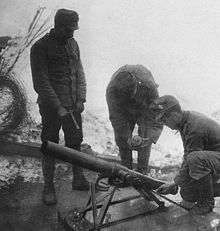9 cm Minenwerfer M 14
| 9 cm Minenwerfer M 14 | |
|---|---|
 | |
| Type | Light trench mortar |
| Place of origin | Austria-Hungary |
| Service history | |
| In service | 1914-1918 |
| Used by | Austria-Hungary |
| Wars | World War I |
| Production history | |
| Designer | TMK |
| Designed | 1914 |
| Produced | 1914-17? |
| Variants | M 14/16 |
| Specifications | |
| Weight | 72 kilograms (159 lb) |
| Crew | 3 |
|
| |
| Shell | 2 kilograms (4.4 lb) |
| Caliber | 90 mm |
| Breech | interrupted-screw or cylinder lock |
| Effective firing range | 199 metres (218 yd) (M 14) |
| Maximum firing range | 345 metres (377 yd) (M 14/16) |
The 9 cm Minenwerfer M 14 (Trench mortar) was a light mortar used by Austria-Hungary in World War I. It was designed by the Army's own Technisches und Administratives Militär-Komitee (TMK) in an effort to quickly satisfy the demand from the front for a light mortar. It had a number of issues with its ammunition, namely the black powder used as a propellant gave off copious smoke clouds on firing that revealed the tube's location and the mortar bomb fuzes had a high rate of failure. The breech-loading mortar tube was mounted on a framework that didn't allow for any traverse, which meant that it was impossible to engage different targets without relaying the mortar. In turn the frame was mounted a rectangular firing platform.
The M 14/16 had a circular platform to provide traverse and weighed only 65 kilograms (143 lb). A later model allowed the mounting to be collapsed for ease of transport. A new M 16 mortar bomb that used the German Poppenberg fuze system generally cured the dud problem, but it still used black powder as its propellant. This was a severe tactical disadvantage and it was decided to purchase replacement mortars from the German firm of Heinrich Lanz from 1917.
References
- Ortner, M. Christian. The Austro-Hungarian Artillery From 1867 to 1918: Technology, Organization, and Tactics. Vienna, Verlag Militaria, 2007 ISBN 978-3-902526-13-7